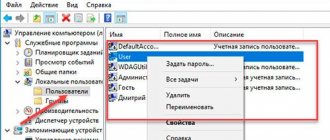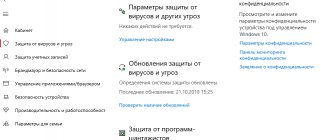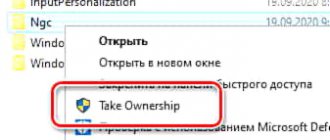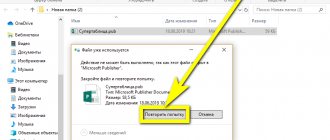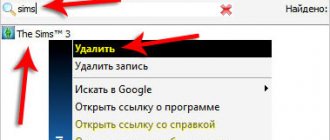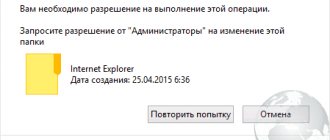Third Party Tools
Solutions that will help you delete unremovable folders include special utilities and third-party file managers.
Method 1: Special utility
The problem with erasing certain objects also occurs on older versions of Windows, so enthusiasts have released many applications that will help unlock the option to delete them. To solve this problem, we recommend using the Unlocker utility, whose algorithms are effective in most situations.
Lesson: How to use Unlocker
Method 2: File Manager
Windows 10 Explorer is sometimes unable to erase some data due to its own limitations. The latter are absent from third-party file deletion programs, which makes them effective in solving the problem at hand. As an example, we use the popular Total Commander application.
- Launch the program after installation and use one of the file panels to navigate to the location of the folder you want to get rid of.
- Select the directory by single-clicking the left mouse button, then use the F8 key on the keyboard or the corresponding item in the bottom panel.
- A confirmation window will appear, click “Yes” in it.
Most likely, the problematic directory will be deleted without any problems.
Reasons for an error appearing on a computer
If a folder on your Windows 10 computer is not deleted, you should pay attention to the following factors:
- The files are being used by some application. The system will notify you about this when attempting to fix it.
- The user does not have the necessary permissions.
- The folder is being used by another computer connected via the local network.
- Violation when writing files. When objects with compromised integrity appear, the operating system closes access. The solution is to use special utilities.
- The files or folder are quarantined by antivirus software (software). You can try to delete the file from there yourself or temporarily disable the antivirus.
System Tools
If you do not have the opportunity to use certain solutions from third-party developers, you can get by with tools that are purely built into the OS.
Method 1: Removing service directories
If the folder intended for deletion contains service data (for example, Temp and Windows.old), you can use the instructions for cleaning the system disk of garbage, the link to which is provided below.
Lesson: How to clean drive C
Method 2: Closing the blocking program
Most often, erasing certain directories is not available due to the fact that they are currently being used by one or another application. Therefore, the solution in such a situation would be to close the program.
- Use the taskbar: find open software on it and close it.
Attention! If you have any documents open in the program, you should save your changes first!
- If the program does not respond or is not in the list of running ones, then there are two courses of action. The first is to restart the computer. The second is to use the “Task Manager” to terminate the stuck process. You can launch this snap-in in several ways - for example, you can move the cursor over an empty space on the taskbar, right-click and select the appropriate item in the context menu.
Lesson: How to open Task Manager in Windows 10
- In the tools, go to the "Details" tab and find there the process related to the problematic application. Select the desired entry and right-click on it. Next, use the “End process” option.
The operation requires confirmation, click “End Process” again.
Now the target directory can be deleted without problems.
Method 3: Removing write protection
Some directories in Windows can be protected from overwriting - the object properties have the “Read Only” attribute. To erase such data, you will need to remove it.
- Select the target object, right-click and select the “Properties” option.
- On the General tab, find the Attributes section. Uncheck the Read Only box, then click Apply.
A confirmation pop-up window will appear. It needs o.
Repeat the removal procedure, now it should go through without any problems.
Method 4: Setting object access rights
In some cases, a particular directory cannot be deleted due to the lack of suitable access rights. If your account has administrator rights, you can unlock full access to the object.
Is it possible to remove non-deletable folders from a PC?
How to remove Windows.old and what is this folder
Everything located on drive D, in most cases, can be deleted. The situation is more complicated with drive C - the data that is there may be necessary for Windows to work. A corresponding warning will appear about this. Forcibly deleting files in Windows 10 can cause serious problems.
The system has requested permission to delete a folder from the system drive
Note! To avoid unpleasant consequences, it would be wise to create a restore point before deleting any folders on the C drive. This way you can return the system to its previous settings at any time.
How to delete data in Safe Mode
This method is also not too complicated. Since only the most necessary system processes work in this mode, a directory that could not be deleted before may well be deleted in this mode. To do this, you first need to enter “Safe Mode”:
- Using the same Win+R key combination, open “Run”. There, in the empty field, you need to enter the msconfig command, click on “OK”.
- In the next window, open the “Download” tab.
- Check the box next to the “Safe Mode” option. Click "Apply" and then "OK".
WinSxS folder - how to clean it on Windows 10
All that remains is to restart the computer and try to delete the directory in safe mode.
It is worth noting! In order for the system to start in normal mode, you need to follow the same steps, then uncheck the box and confirm with the “Apply” and “OK” buttons.
Delete or permanently delete files from the File Explorers feed
You can also navigate to the files you want to delete in File Explorer and select them. Then click or tap the Home tab on the ribbon, and then the Remove button. This action will remove the selected item(s) and move them to the Trash.
Deleting a file from the Home tab in File Explorer
If you want to delete a file permanently, select it. On the Home tab of the ribbon, instead of clicking the Delete button, click the arrow below the Delete button, and then select Permanently Delete.
Delete a file permanently from the Home tab in File Explorers
Delete Files Permanently
Shareware
Delete Files Permanently is a fairly powerful utility for destroying files, folders and disks, supporting all common data erasing algorithms, including the domestic one according to GOST R 50739-95. The program even works on old computers running Windows 98 (all subsequent OS versions - up to Win 10 - are also supported). The interface is made in English.
Using Delete Files Permanently?
The program works according to the standard scheme:
- Add the files/folders to be destroyed into the program (the “Wipe Files and Folders” tab).
- Select one of 14 data erasing methods (drop-down menu “Wiping Scheme”).
- Click the “Delete Permanently” button and you’re done.
The Delete Files Permanently utility is also capable of erasing free space on hard drives and other media (the “Wipe Free Space” tab):
You can also use it to quickly destroy the contents of the Trash. In this case, it is possible to select the local disk to which the “Trash” is linked (the “Wipe Recycle Bin” tab):
The Delete Files Permanently program has two unique functions (at least, all previous utilities do not have them), one of which is the destruction of the names of previously deleted files from the selected local drive (the “Wipe Deleted File Names” tab). Here we mean erasing data in the file system in such a way that the “body” of the file remains intact, and only its name is deleted. This operation is somewhat reminiscent of overwriting free space on disks, but it is performed many times faster and serves, rather, to “quickly cover up tracks.”
The second unique feature is the ability to set a password to enter the program (perhaps this is important for someone). To install it in the program settings (the “Settings” tab), you need to check the box next to the “Protect Wipe Deleted File Names with password” item, and then enter the password in both fields below. Here – in the settings – you can set the data erasing algorithm that will be used by default.
Folder cannot be deleted in Windows 10
In Windows 10, a user with administrator rights can freely copy, move, or delete folders and the files they contain. The exception may be important system directories. However, sometimes the user is faced with a situation where a completely “ordinary” folder cannot be deleted.
Why the folder is not deleted in Windows 10
Folders in Windows 10 may not be deleted for the following reasons:
- This is a system folder and is critical for the operation of the OS;
- the folder is protected from editing by another user, program or the system itself;
- files inside the folder are used by another application, system, user or computer via remote access;
- your account does not have the appropriate access level.
Also, deleting folders can be complicated due to viruses, but they can still be attributed to one of the reasons above. Typically, virus software simply protects against editing, creates access to files in a folder, or generally forces the folder to be mistaken for an important system object.
Next, we’ll look at possible options for deleting folders in Windows 10. This can be done using both third-party and built-in system tools.
Option 1: Unlocker program
This program is specifically designed to delete undeletable files. As a rule, it copes well with those objects that are protected from editing or are used by some other program/process. The program is very easy to manage. It requires preliminary installation, but it takes up minimal free space and practically does not load the computer.
Instructions for deleting a folder using the Unlocker program are as follows:
- Right-click on the folder you want to delete using Unlocker. Please note that for further work you will need administrator rights.
- The program will search for a blocking handle in order to eliminate the reason for blocking the folder, after which you will have the opportunity to delete it.
- Click on “No action”. In the drop-down list, select the “Delete” option and click the “Ok” button to apply.
After a few seconds, you will receive a notification that the selected item has been successfully deleted.
Option 2: Total Commander
It is a third-party alternative to the standard Windows Explorer. It has expanded functionality compared to its prototype. Including the ability to remove those components that the standard “Explorer” cannot normally remove. To delete a non-deletable folder in Windows 10 using Total Commander, follow these instructions:
- Use one of the software panels to navigate to the folder you want to delete. Select this folder.
- Press F8 to open the delete panel.
- Confirm deleting the folder in the pop-up window by clicking “Yes”.
Option 3: Close the blocking program
If some component from the folder being deleted is used by another application currently running in Windows, then deleting this folder will not work. The solution in this situation is as simple as possible - close the program that uses the folder or components from it.
- First, try simply closing the “problematic” program.
- Sometimes a program may leave background processes running after it closes. In this case, it will also not be possible to correctly delete the desired folder. You can view the list of background processes and disable them through the “Task Manager”. Open it using the keyboard shortcut Ctrl+Shift+Esc.
- Among the active processes, find the one that is responsible for the operation of the previously closed program. See the “Background Processes” section.
Option 4: Unprotect the folder
Some folders in Windows can be protected both by the system itself and by the user. The object properties will have a read-only attribute. Its presence limits many actions with the folder, including its deletion. To remove these restrictions, you will need to make changes to the folder properties:
- Right-click on the desired folder and select “Properties” from the context menu.
Option 5: Setting permissions
Sometimes it is not possible to delete a particular directory due to the lack of appropriate access rights for it. Full folder access can only be unlocked through an administrator account.
- Open the “Properties” of the desired folder and go to the “Security” tab.
- There, click the “Advanced” button.
Option 6: Uninstall via “Command Line”
Using the built-in Command Line utility, you can perform some actions that are not available in normal graphical mode. The deletion of directories whose uninstallation is impossible in graphical mode was no exception:
- Run Command Prompt as an administrator. This can be done in any convenient way. As an example, we will open it through the Windows search bar. It can be opened using the magnifying glass icon in the taskbar or the Win+S key combination.
- Enter the name of the object you are looking for in the search bar. In our case, this is “Command Line”. Among the startup options, select “Run as administrator.”
Option 7: Uninstall in “Safe Mode”
If you suspect that a virus or some other malware is preventing you from deleting the desired folder, then perform the deletion in “Safe Mode”. Let's consider one of the options for entering this mode and deleting elements in it:
- To begin, open the “Run” line using the Win+R keyboard shortcut. Enter the msconfig command there and press the Enter key or the “Ok” button to apply it.
- Minimal. The system boots in graphical mode with a set of the most necessary services and drivers for operation.
- Another shell. In this case, the “Command Prompt” becomes fully available for work after booting into safe mode.
- Restoring Active Directory. This mode contains everything you need to restore Active Directory.
- Net. Safe mode starts with support for the “Command Line” and network drivers (it is possible to access the Internet).
These were all the main options for action if for some reason you are unable to delete a particular folder. Finally, let us remind you that unless absolutely necessary, do not perform any manipulations with system files and folders. This may negatively affect the performance of the entire operating system.
